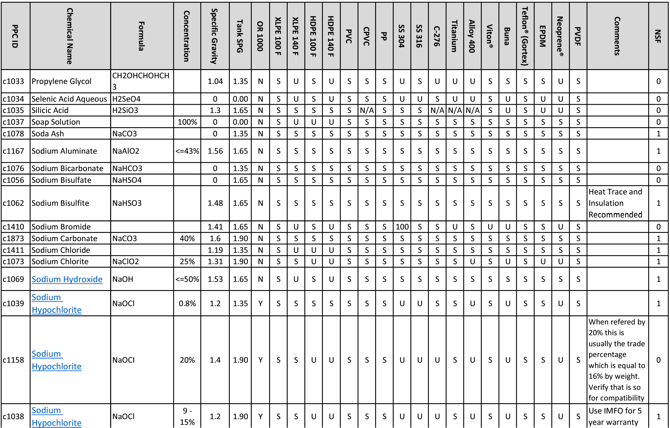How To Use The Chemical Resistance Guide
When storing a chemical, it is critical to be confident that your entire tank system is compatible with the chemical and is up to the task of providing safe storage. To help customers understand the compatibility of specific chemicals with our polyethylene tanks and accessories, we created our chemical resistance guide.
.jpg?width=804&height=422&name=How%20To%20Use%20The%20Chemical%20Resistance%20Guide%20(1).jpg)
Use this vital resource to understand the compatibility of Poly Processing’s tanks, fittings, and gaskets with over 100 different chemicals.
In order to make an informed decision about the options that work with a specific chemical, it’s important to understand how to read the chemical resistance guide. Let’s go through the process of using the guide with an example chemical, sodium hypochlorite.
Understanding The Chemical Resistance Guide
At Poly Processing, our engineers always start with the chemical being stored, and this is no exception. Choose a chemical from the chart and you’ll be presented with a list of categories running horizontally across the top of the table.
Chemical Data
From left to right, our guide lists the following information about the chemical:
- Chemical name
- Chemical concentration
- Tank specific gravity required to safely store the chemical at its given concentration
For the rest of the guide, compatibility is noted as satisfactory (marked with an S) or unsatisfactory (marked with a U).
Tank Material
First, the ratings for our high-density cross-linked polyethylene (XLPE) material options are shown at various temperatures. The XLPE has been tested at 100° and 140°F.
Using our example of sodium hypochlorite, you can see that the formula is NaOCI and that the specific gravity of a tank storing this chemical at 0.8% and must be at least 1.35 specific gravity. A chemical storage tank storing sodium hypochlorite at 9% to 15% must be at 1.9 specific gravity. In many cases, we can store chemicals in XLPE tanks at any other temperatures listed. We recommend you contact a PPC tank expert for guidance regarding temperatures and the chemicals being stored.
Fittings and Gaskets
From there, you can see the various types of fittings (columns PVC-Alloy 400) and gaskets (columns VITON® - NEOPRENE®) that we offer.

For example, you can see that a chemical storage tank holding sodium hypochlorite at 0.8% concentration is compatible with all types of fittings except for stainless steel, and alloy 400, and all types of gaskets except for those made of buna and/or neoprene.
The last box in the row contains any special notes or comments that should be considered when storing the chemical.
Using the Chemical Resistance Guide
All of the information that we use in our chemical resistance guide is based on published data and field experience. You can trust this chemical resistance guide to be reliable, but it is recommended to cross reference this guide with one or two other guides and contact your chemical supplier or manufacturer.
Some chemical compatibility information may vary, based on the size of the tank as well as warranty. We recommend contacting us at 866-765-9957 with any questions regarding this guide. Be sure that you are using the latest revision of this guide.
If you are looking to store a chemical not found in our guide, contact a Poly Processing chemical storage expert today for more information on storage compatibility.
- April 1, 2024
- Topics: Technology Tips
About Poly Processing
Posts By Topic
Tech Talk Podcast Episodes
Subscribe By Email
Recent Posts
- Installation Tips for Chemical Storage Tanks: Site Preparation and Offloading
- Understanding pH and Chemical Concentration When Choosing a Chemical Tank
- Maximizing Fill Efficiency: Selecting the Optimal Fill Line System
- Chemical Storage Tanks: A Quick Guide for End Users
- Popular Customization Options for Chemical Storage Tanks
Tank Configurator

Find the recommended tank and system components for your chemical storage challenge.
Configure a Tank Package





